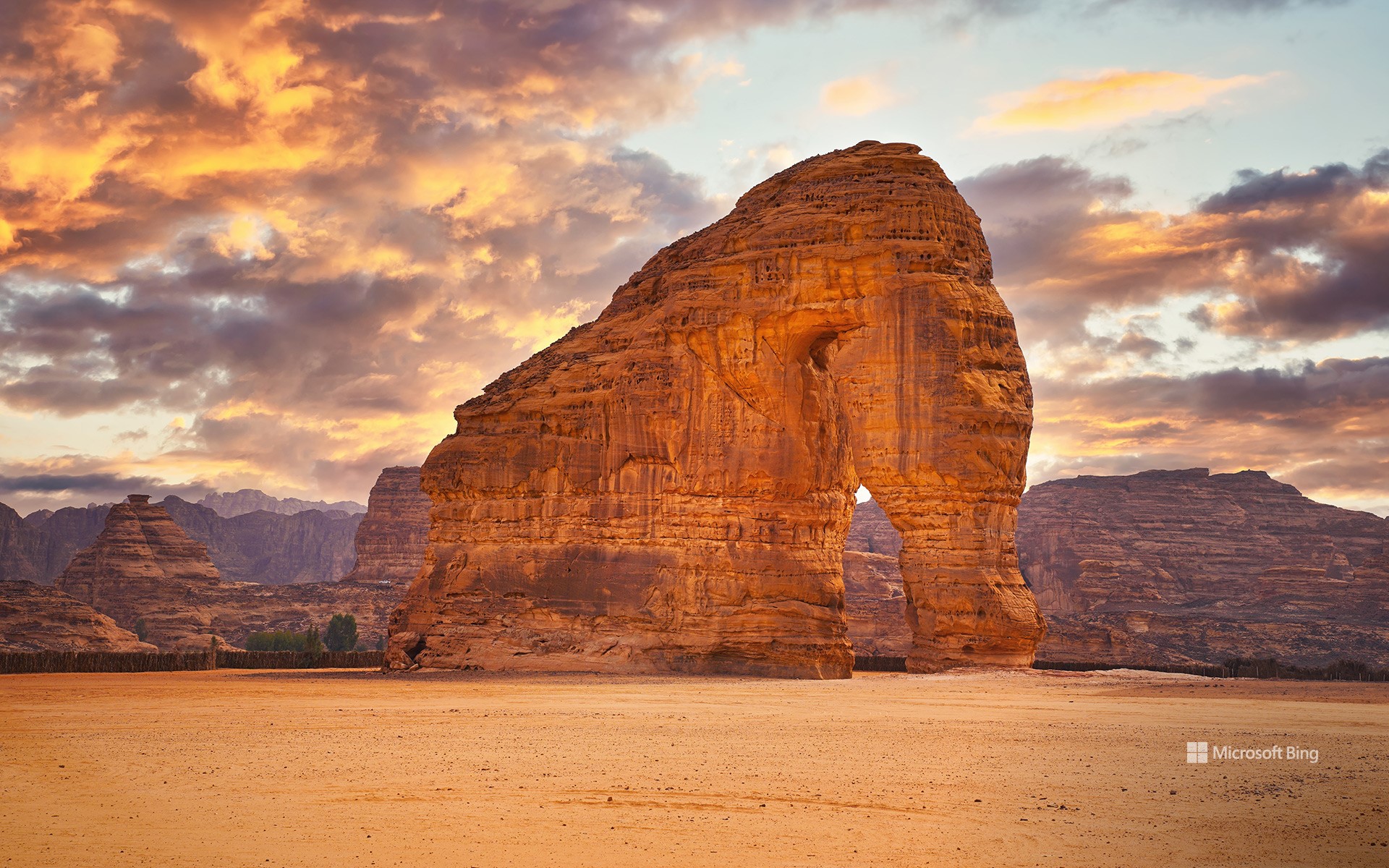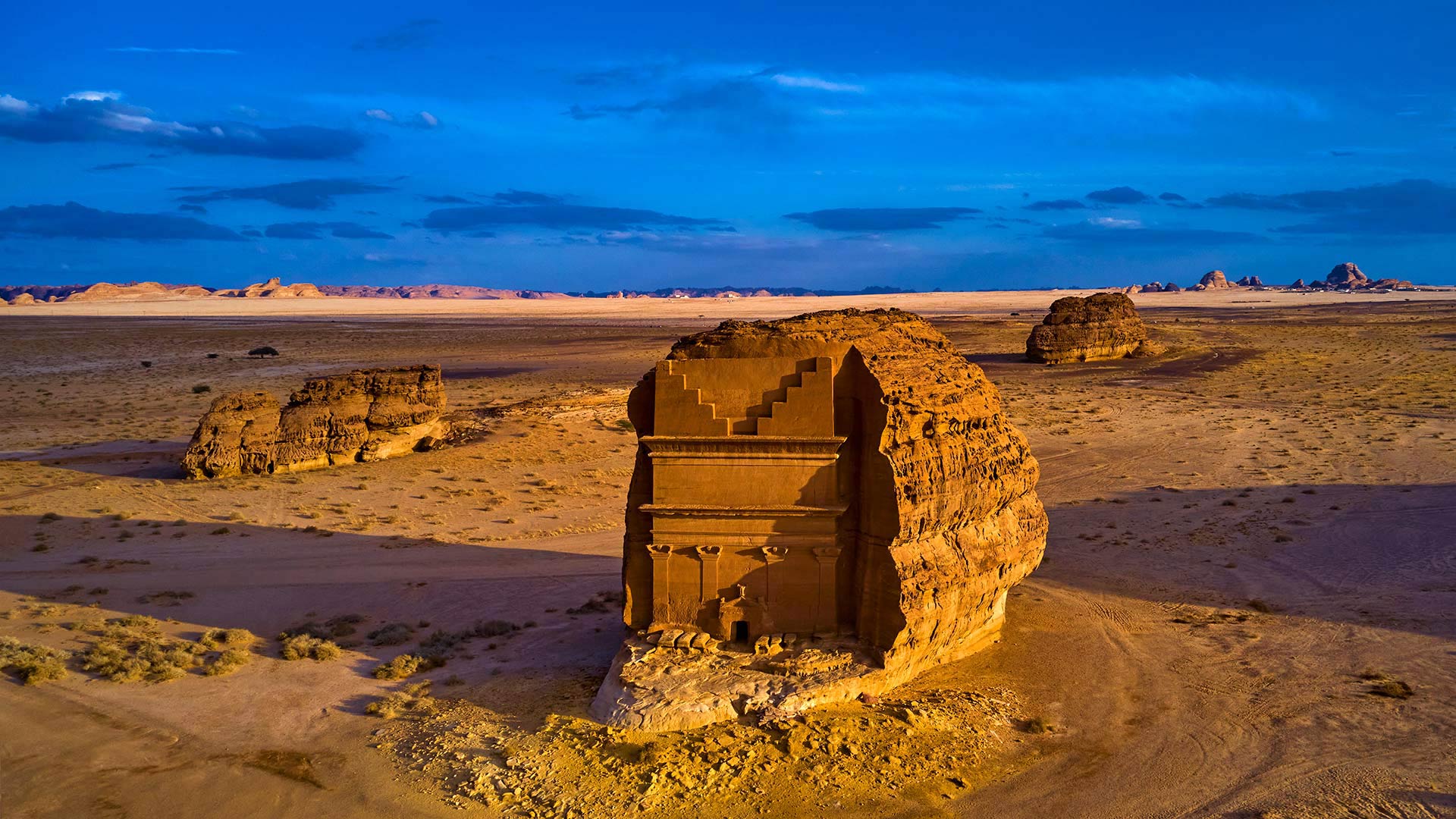标签 沙特阿拉伯 下的文章
大象岩,古城欧拉,沙特阿拉伯 Elephant Rock, Al-Ula, Saudi Arabia (© Lubo Ivanko/Shutterstock)

大象岩,古城欧拉,沙特阿拉伯 Elephant Rock, Al-Ula, Saudi Arabia (© Lubo Ivanko/Shutterstock)
温柔的“沙丘巨人” Gentle giant of the dunes
大象岩,古城欧拉,沙特阿拉伯
经过数百万年的时间,大自然雕琢出了这片耀眼夺目的砂岩地貌,名为大象岩。该岩石高达117英尺,位于沙特阿拉伯古城欧拉附近,由于风水的侵蚀,它呈现出大象的形状,并成为了该地区的著名地标。日落时,夕阳洒在这片沙漠上,为红色的“猛犸象”及其周围金色的沙子镀上一层温暖的光辉。
古城欧拉距离大象岩约7英里,其历史可追溯到公元前6世纪,它见证了商人、朝圣者和商队穿越这片干旱的土地的历史。其周边地区的岩层和赫格拉纳巴泰古王国陵墓有着岩画和碑文,其中一些碑文的历史可以追溯到公元644年。
Elephant Rock, Al-Ula, Saudi Arabia
Over millions of years, the dazzling sandstone formation known as Elephant Rock was carved by nature. Thanks to the wind and water erosion, this 117-foot-high rock near the city of Al-Ula in Saudi Arabia took on the shape of an elephant and has become a prominent landmark in the region. As the sun sets, it casts a warm glow upon the red-hued mammoth and the golden sand of the surrounding desert.
About 7 miles from the Elephant Rock, the city of Al-Ula traces its roots back to ancient civilizations and has witnessed the passage of traders, pilgrims, and caravans crossing its arid landscapes. The surrounding area, including rock formations and Hegra's Nabataean tombs, boasts petroglyphs and inscriptions, some dating as far back as 644 CE.
玛甸沙勒(也被称为黑格拉)的纳巴泰墓,沙特阿拉伯 Nabatean tomb in Mada'in Saleh (aka Hegra), Saudi Arabia (© Tuul & Bruno Morandi/Getty Images)

玛甸沙勒(也被称为黑格拉)的纳巴泰墓,沙特阿拉伯 Nabatean tomb in Mada'in Saleh (aka Hegra), Saudi Arabia (© Tuul & Bruno Morandi/Getty Images)
孤独的城堡 The lonely castle
Mada'in Saleh, Saudi Arabia
About 2,000 years ago, Mada'in Saleh, or Hegra as the Romans called it, was a thriving city of the Nabataean Kingdom, and a center for the trade of spices, incense, and myrrh, a valuable tree resin used to make perfume and medicine. The Nabataeans were Arab people whose precise origins are unknown. They lived in northern Arabia and the Southern Levant. Mada'in Saleh was their second-largest and southernmost city after Petra, their capital city to the north. About halfway between Petra and Mecca, Mada'in Saleh served primarily as a trading crossroads and was instrumental in establishing the Nabataeans as prosperous middlemen to the rest of the ancient world.
Today it is one of Saudi Arabia's most celebrated historic treasures, and a UNESCO World Heritage Site, distinguished by more than 100 tombs with ornate facades, carved from sandstone outcroppings on the outskirts of the city. The smallest is less than 10 feet tall, the largest more than 60. Most of the tombs were carved in groups, but this especially embellished monument is relatively isolated, which is why today it's known as the Qasr al-Farid (the Lonely Castle). Here in this windswept desert the bustle of merchants and the caravans full of spices are long gone, but these hand-carved boulders rising abruptly out of the landscape remain as evidence of a time when all roads led to Hegra.
沙特阿拉伯Mada'in Saleh
大约2000年前,马丹·萨利赫(Mada'in Saleh)或罗马人所称的赫格拉(Hegra),是纳巴坦王国的一个繁荣城市,也是香料、香料和没药(一种用于制造香水和药物的贵重树脂)的贸易中心。纳巴塔人是阿拉伯人,其确切起源尚不清楚。他们住在阿拉伯北部和黎凡特南部。马丹·萨利赫是他们的第二大也是最南端的城市,仅次于北部的首都佩特拉。大约在佩特拉和麦加之间的半路上,马丹·萨利赫主要充当贸易十字路口,并帮助纳巴塔人成为通往古代世界其他地区的繁荣中间人。
今天,它是沙特阿拉伯最著名的历史珍宝之一,也是联合国教科文组织世界遗产地,以100多座陵墓为特色,这些陵墓的正面装饰华丽,由城市郊区露出地面的砂岩雕刻而成。最小的不到10英尺高,最大的不到60英尺高。大多数坟墓都是成组雕刻的,但这座特别装饰的纪念碑相对孤立,这就是为什么今天它被称为卡斯尔·法里德(Qasr al-Farid,孤独城堡)。在这片狂风肆虐的沙漠中,商人的喧嚣和装满香料的商队早已消失,但这些手工雕刻的巨石从景观中突然升起,仍然是所有道路通往赫格拉的证据。